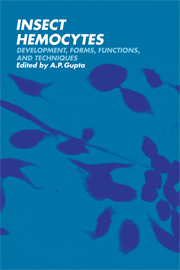Book contents
- Frontmatter
- Contents
- Preface
- List of contributors
- Part I Development and differentiation
- Part II Forms and structure
- 4 Hemocyte types: their structures, synonymies, interrelationships, and taxonomic significance
- 5 Surface and internal ultrastructure of hemocytes of some insects
- 6 Fine structure of hemocyte membranes and intercellular junctions formed during hemocyte encapsulation
- 7 Controversies about the coagulocyte
- 8 Controversies about hemocyte types in insects
- 9 Hemocyte cultures and insect hemocytology
- 10 Pathways and pitfalls in the classification and study of insect hemocytes
- Part III Functions
- Part IV Techniques
- Indexes
5 - Surface and internal ultrastructure of hemocytes of some insects
Published online by Cambridge University Press: 04 August 2010
- Frontmatter
- Contents
- Preface
- List of contributors
- Part I Development and differentiation
- Part II Forms and structure
- 4 Hemocyte types: their structures, synonymies, interrelationships, and taxonomic significance
- 5 Surface and internal ultrastructure of hemocytes of some insects
- 6 Fine structure of hemocyte membranes and intercellular junctions formed during hemocyte encapsulation
- 7 Controversies about the coagulocyte
- 8 Controversies about hemocyte types in insects
- 9 Hemocyte cultures and insect hemocytology
- 10 Pathways and pitfalls in the classification and study of insect hemocytes
- Part III Functions
- Part IV Techniques
- Indexes
Summary
Introduction
Numerous light microscopic observations concerning the classification of insect hemocytes have been published (Yeager, 1945; Wigglesworth, 1959; Nittono, I960; Jones, 1962, 1964; Gupta, 1969; Arnold, 1972). However, there are considerable differences of opinion concerning hemocyte classifications and terminologies. There are also some remarkable differences between the hemocyte types in various insect orders. For example, in the larva of Prodenia eridania, Yeager (1945) recognized 10 classes, containing 32 types of hemocytes; in Bombyx larvae, Nittono (1960) reported five classes of hemocytes: prohemocytes (PRs), plasmatocytes (PLs), granulocytes (GRs), spherulocytes (SPs), and oenocytoids (OEs). Gupta (1969) classified insect hemocytes into eight types: PLs, GRs, OEs, SPs, adipohemocytes (ADs), podocytes (POs), vermicytes (VEs), and cystocytes (= coagulocytes, COs). Some authors recognize only three basic classes: PRs, PLs, and GRs. It also appears that there is greater differentiation of hemocytes in higher insect orders than in lower ones (Jones, 1962, 1964) (see also Chapter 4). Some authors consider amoebocytes, lamellocytes, POs, and VEs as various forms of PLs; COs and VEs as various forms of PLs; and COs and ADs as belonging to the category of GRs.
Recent electron microscopic studies have proved helpful in distinguishing various hemocyte types. For example, in Bombyx mori, the larval PLs and GRs, which were frequently indistinguishable under the light microscope, were clearly identifiable by their ultrastructures (Akai and Sato, 1973; Akai, 1976). Scanning electron microscopic (SEM) studies of the insect hemocytes also are necessary to elucidate their characteristic surface structures. Such studies are likely to supplement the information obtained by light and transmission electron microscopic (TEM) observations.
- Type
- Chapter
- Information
- Insect HemocytesDevelopment, Forms, Functions and Techniques, pp. 129 - 154Publisher: Cambridge University PressPrint publication year: 1979
- 10
- Cited by



